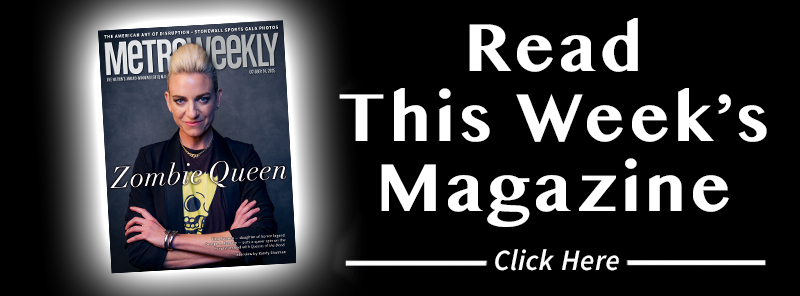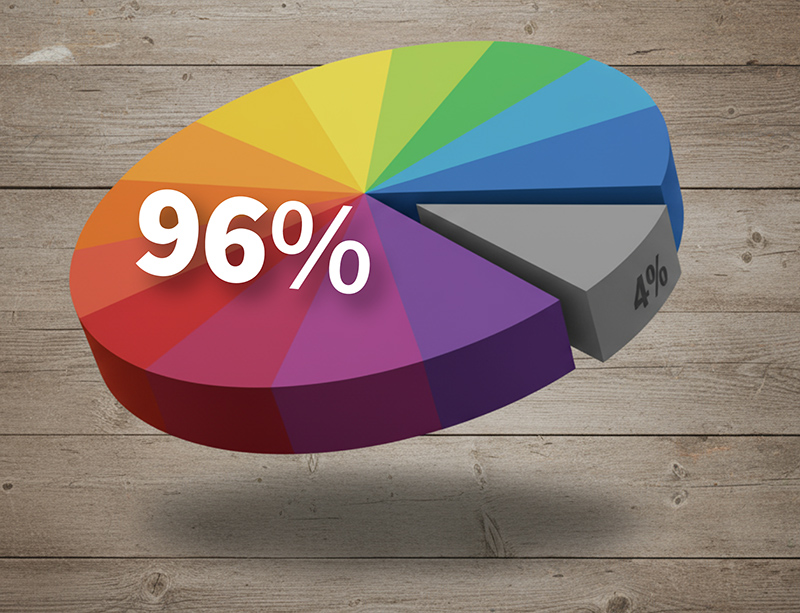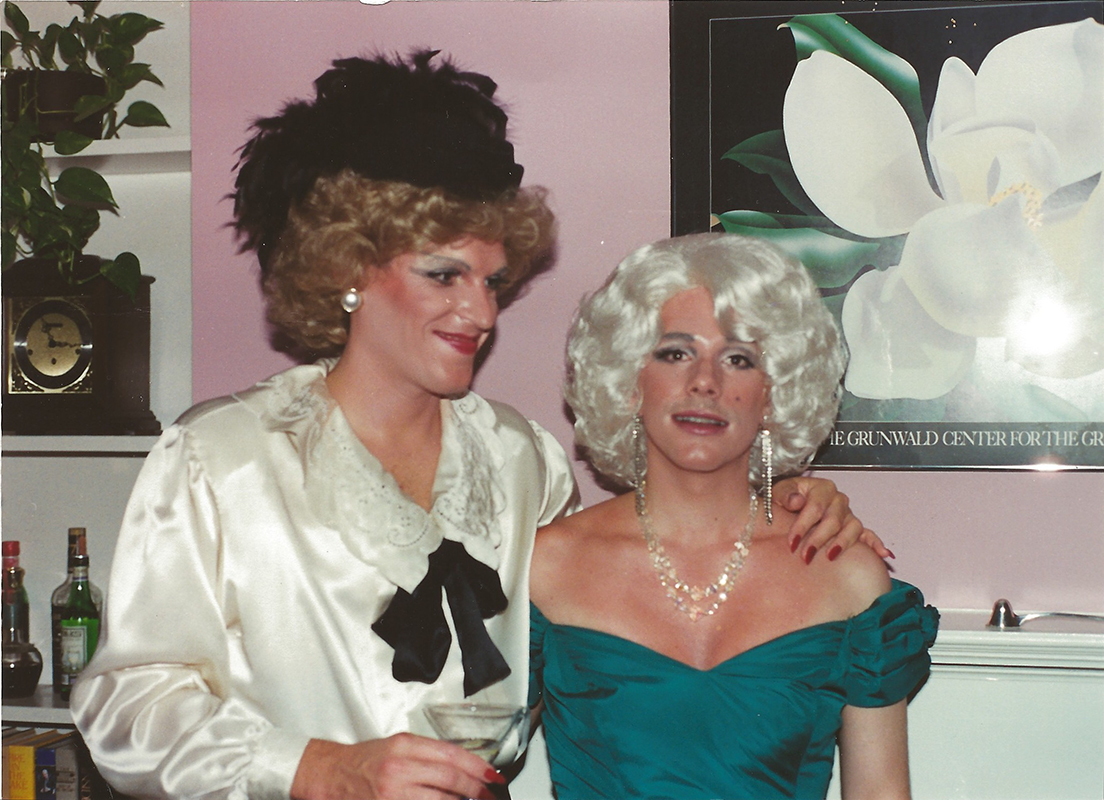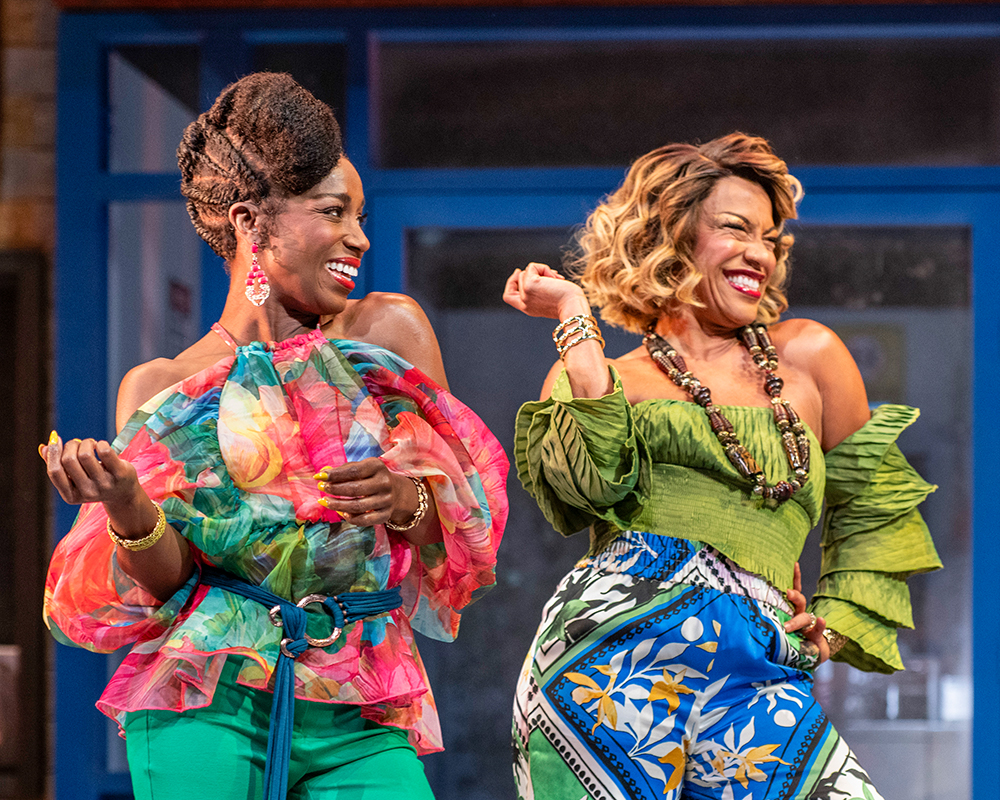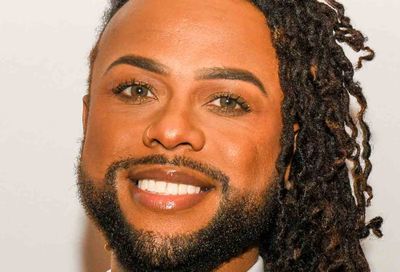Lypsinka Dearest
John Epperson, as icon Lypsinka, recreates Hollywood legend, Joan Crawford, at Studio Theatre
John Epperson’s favorite Joan Crawford film is Berserk.
The one with the ax?
”No,” he corrects the reporter gently, ”that one was called Straight Jacket. Berserk was the circus movie.”
There is a pause. A dramatic pause.
”The glamorous, color circus movie!”
 |
To that end, Epperson’s having a special Berserk Room installed at the Studio Theatre. There, he’ll greet the audience following each performance of The Passion of the Crawford, in which Epperson as Lypsinka portrays Hollywood legend Joan Crawford. A 1973 recorded interview conducted with the star serves as his lip-syncing source material.
Anyone who’s seen the Mississippi-born Epperson perform as Lypsinka — he was last here as the fiery, manic diva in 2002 in Lypsinka! The Boxed Set — knows the wonder and magic he produces on stage. His lip-syncing abilities are transcendent, a dazzling blend of comedy, camp and dramatic flourishes. But for someone who has spent his career miming — with exacting, rapid-fire precision — to the music and words of others, Epperson is, during an interview situation, never at a loss for words of his own. To say he’s outspoken is an understatement.
”I’m much more highbrow than people think I am,” he says during a recent phone conversation from his home in New York. ”I don’t mean that to sound immodest but, you know, most drag queens are considered flibberty-gibbets. And I am so not. I think often people are afraid to hire a drag performer because they have such bad reps. But I am the most reliable person I know.”
The Passion of the Crawford has its roots eight years ago, in 1998, at Manhattan’s Town Hall, where Epperson tried out an abbreviated version of the Crawford material. It wasn’t until several years later, in 2004 that Epperson fully fleshed the show out, performing it first in L.A., and later in San Francisco, where it was a hit. But, he adds with a wry laugh, ”Joy Zinoman [the Studio’s artistic director] could dress up as Joan Crawford in San Francisco and have a hit. Anyone could do it. There are so many gay guys that love Joan Crawford in San Francisco, you can’t go wrong.” The Studio Theater’s production of Passion is the first time it’s played Washington, and Epperson can barely contain his excitement.
”The Washington audience is very smart,” he says. ”They are a literate crowd. I appreciate that.”
Intellect is important to Epperson, also a trained classical pianist. In fact, he unabashedly proposes that he’s probably ”the only drag performer in the world who’s read Jane Austen, Thomas Hardy, The Rise and Fall of the Third Reich and can play a Chopin waltz at the piano.”
METRO WEEKLY: This year marks the 25th Anniversary of the creation of your iconic character, Lypsinka. Can you give me a brief refresher on how she came into being?
JOHN EPPERSON: When I was in college, in the ’70s, I saw drag performers at the local gay bar in Jackson, Mississippi. They took themselves pretty seriously, and would dress up in ball gowns and lip sync to Dionne Warwick. At the same time I was reading about Charles Ludlum, who created the Ridiculous Theatrical Company here in New York. I remember reading a review of his show Camille in Time magazine, and I thought, ”Wait a second, you can get in drag and get in Time magazine and it doesn’t have to be that kind of boring drag that they’re doing at the local gay bar? What they could be doing at the local gay bar is absurd theater!” So I started thinking, ”How can I do a lip syncing show but make it absurd, like Charles Ludlum?” It was an idea that was forming in the back of my mind for quite some time.
Then, in the summer of ’81, I visited Paris and went to a nightclub called Michou. It was very much like Victor, Victoria. You’d give your order to a waiter and then before you knew it, the waiter was on the stage dressed as Liza Minnelli, lip syncing to her. It was the best lip syncing I had ever seen. So I started thinking more about my idea. I thought my name should be like a one-name exotic fashion model — plus it should tell the audience what they’re going to see. And that’s how it came to be.
MW: There are two types of drag queens on the performing circuit. Those who sing their own material and those who lip sync. What you do, however, takes the lip syncing to a whole new level of performance art. So is it fair to refer to you as a drag queen?
EPPERSON: I loathe the term drag queen. It’s so limiting. It has all kinds of negative connotations of a person who sits around drinking and putting makeup on all day. And it often is used disparagingly.
MW: So what do you call yourself? A female impersonator?
EPPERSON: No, that sounds too clinical and gender illusionist. I don’t even like the label ”actor” because I’m also a writer. So I can’t say I’m just an actor.
MW: Performance artist?
EPPERSON: That sounds so non-profit. [In 2004,] I did a singing and speaking role with my own voice, mind you. They cast me as the stepmother in Rogers and Hammerstein’s Cinderella at the New York City Opera at Lincoln Center — it’s as close as I’ve gotten to Broadway. I went to their Web site when we were in rehearsals and they had called me a ”cabaret artist.” And I said, ”No, no, no, no, we’ve got to come up with something else.” So we came up with ”Post-Modern Male Actress.” But even that was confusing to some people who don’t know what post-modern means.
They wanted to use the name Lypsinka in their marketing, so they actually used John ”Lypsinka” Epperson. I never intended for Lypsinka to just lip sync, but because of the name, people tend to think that’s the only thing I can do. Recently the New York Times called me ”the voiceless drag artist.” Well, God damn it, didn’t you see me in Cinderella? I used my own fucking voice. It’s so limiting. It’s a conundrum. I guess it always will be.
 |
MW: Have you ever done lip sync out of Lypsinka character? EPPERSON: Well, with the show that we’re about to do at Studio, we’re saying is John Epperson as Lypsinka as Joan Crawford. So that’s one character right there but with another one behind it.
MW: How important to the process is it for you to be dressed as a woman? Could you be dressed as a male character?
EPPERSON: I don’t see why I couldn’t be. I did an autobiographical show in 2004 at Studio as myself — John Epperson: Show Trash — and there was a tiny bit of lip syncing in that show. I was dressed as myself in my street clothes. So I could do a show, I guess, out of drag, doing all lip syncing. Jerry Lewis used to lip sync, and so did Andy Kauffman.
MW: Do you think audiences would embrace that as much as they do Lypsinka?
EPPERSON: Well, they may not. Part of the appeal of Lypsinka is that it’s a man in a dress, and there’s something forbidden and titillating to the audience about that. Almost like they’re watching something they shouldn’t but they can’t help themselves. They want to see it. Because a man in a dress in our society is still quite a taboo thing.
MW: Since you began doing this 25 years ago, what have you noticed in terms of cultural attitude changes toward it?
EPPERSON: Well, now you can win a Tony Award for putting on a dress. Harvey Fierstein [in Hairspray] — that couldn’t have happened 25 years ago, I don’t think. And when I started doing it, I said to myself, ”This is not going to be easy, because a man in a dress has all kinds of problems.” But I wanted to do it — I felt compelled to do it. I also figured it would be a good way to get into show business knowing that it might pigeonhole me, but at least I’d be in show business.
MW: From your point of view, and aside from the ”forbidden” nature of it, what do you think is so captivating about Lypsinka to people?
EPPERSON: Well, you’ve heard of the man you loved to hate? Like Cruella de Ville was the woman you loved to hate? I think it’s like a vessel. Lypsinka can say anything and get away with it.
MW: She’s a bit severe, too. There’s an edge to her, a hardness. And I don’t want to call it bitchiness — I don’t think that’s right word….
EPPERSON: Maybe danger is a good word.
MW: That’s a great word for it. How do you bring that sense of danger into Joan Crawford?
EPPERSON: Well, we know things now about Joan Crawford that we didn’t know until she died. We now know that she had a dangerous side to her. Whether or not the stories are true — about the child abuse — only Christina really knows.
MW: How is the current show constructed?
EPPERSON: The show is an actual interview that Joan Crawford did in 1973. Another actor, Steve Cuiffo, plays the interviewer. Although I don’t believe there was any tension between Joan Crawford and the man who interviewed her — who happened to be her publicist — because it’s theater we try to give the interview some tension.
MW: Do you pull from her movies as well?
EPPERSON: No, it’s mostly taken from the live interview and from some television appearances that she did.
MW: So we’re actually getting to ”meet” Joan Crawford. The purpose of this, it seems to me, is for Lypsinka to channel and embody Joan Crawford.
EPPERSON: It bores me that when most drag performers do a Joan Crawford impersonation nowadays, they just do the Mommie Dearest kind of Joan Crawford. She was more complicated than that. There are some people who say that Joan Crawford was one of the nicest people they’ve ever met and there are other people who say she was the biggest bitch they ever met. I think she was probably both in one person. After all, we’re all complicated, we all have different sides. We know she had a dark side — but she also had a lighter side. I think she was deeply misguided in her attitudes about child rearing, but she wasn’t a totally bad person.
I wanted to do a real version of Joan Crawford. Yes, the show is funny, but I wanted to present her as real as possible, as real as you can through the very artificial form of theater that I do. Joan Crawford was one of the most fascinating icons of the 20th century, and when you think about people like Elvis Presley and Marilyn Monroe and Judy Garland, who were also great metaphorical icons of the 20th century, who were people who embodied the best and worst of the American dream, the three of them, while they were alive, were troubled. We all knew it. It was publicized. You could see it in their appearance, especially Garland and Presley. But Joan Crawford did not die young the way the three of them did. She was at least 70 and we didn’t know about her dark side until after she was dead. Somehow there was an unwritten pact between her and the press. Even though people in the business knew about her troubles with her kids and about her drinking, they never printed it. They sort of respected her somehow. Like the Queen of Hollywood.
MW: What is it about Joan Crawford that draws….
EPPERSON: Why so many gay men are drawn to her?
MW: Yes. I know it’s an obvious question, but you’ve done some research into this, so maybe you have some new insight.
EPPERSON: I think one possibility could be that gay men and gay women, too, are outsiders in the world. We were told from the moment we were born to not be what we are. And I think one reason we’re drawn to very talented people is because we realize that the talent of that person sets us apart from the rest of the world.
A very beautiful person often feels like an outsider. Joan Crawford was very beautiful. I think also women like Crawford and Bette Davis had very masculine sex drives, and somehow, on some kind of subliminal level, that drive comes through in the image on the screen. We respond to that subliminal thing, whether we’re aware of it or not.
You know, toward the end when Crawford got to be sort of a ”grande lady” there was also a part of her, and it comes through in this interview [we use in the show], that just wanted to be one of the guys and get drunk and get laid.
MW: Of all the shows you could have done, why chose to focus on just one figure? Why this direction for you?
EPPERSON: Oh, God, you say this direction. That scares me because it sounds like I’m becoming known as ”The Joan Crawford Impersonator” — which is what I am becoming known as, unfortunately. I never intended to be that. But I think one of the reasons is that there is so much material available about her. I can simulate Joan Crawford to a degree. I don’t think I look like Joan Crawford and don’t really want to look exactly like Joan Crawford — that’s not my intention. Joan Crawford was very beautiful. I do not see myself as beautiful. But she’s fascinating, she’s complex, and she deserves a better drag performance than you usually see. You know, drag queens on Halloween running around with an ax dressed as Mildred Pierce. It’s tired, it’s not funny anymore.
The audience is going to have to come to this show with a different mindset because it is not manic like my other shows. It’s very slow and sustained, although there is a payoff at the end. The audience should come with an adventurous mind.
Advertisement
|
MW: They should come expecting something new from you.
EPPERSON: Yes. It is my job as an ”artist” — and I hate to use the word because it sounds so pretentious — to change and grow and to try different things.
MW: In so many performances, you must have had a moment when you missed the cue.
EPPERSON: Oh, I think I probably have but sometimes it goes by so fast you might not notice.
MW: If you miss a cue, how do you recover from it?
EPPERSON: Just keep going. You can’t stop once that soundtrack starts. There’s nothing you can do but keep going.
MW: You design your own soundtracks?
EPPERSON: I do. I sit with a recording engineer to do it. Passion of the Crawford is especially hard because almost all of it is the spoken word. It’s much easier to lip sync to music because music has a rhythm to it. The spoken word does not. She does a lot of ”ummms and aaahs” and pauses. And you have to time all of that out.
MW: It’s like words and music to you.
EPPERSON: Yes, it’s like words and music. But the words are the music.
MW: How is your life? How are things?
EPPERSON: Well, my life is good. I don’t have much of an intimate personal life, if that’s what you’re getting at. Like Vincent Minnelli, I’m mostly interested in work because work is easier than relationships. I have been involved in a relationship with a guy who is not very available and I’ve pointed that out to him but it hasn’t really changed and so I don’t know what that means. I have plenty to do.
MW: Well, then, are you happy?
EPPERSON: As far as being happy, I don’t believe that anyone should be constantly happy because then you’d be bored with it. I think that happiness comes in fleeting moments and I enjoy that a lot more. I am content, which I think is a better state of being than ”happy.”
But as I said earlier, I just have an incredible life, you know? For a scared little kid from Hazelhurst, Mississippi and to have done the things I’ve done and met the people I’ve met and been the places I’ve been, I think I’m very lucky. I also think I deserve it because I’ve worked my butt off.
MW: A lot of times with gay artists we have the obvious question: How does being gay influence your work? But in your case, if you weren’t a gay man, you may not have ventured into this line of work. You may have gone on a different artistic path.
EPPERSON: Being gay made me an artist, I think. But I’m very ambivalent about the gay community wanting to be assimilated into society. My argument is that if Tennessee Williams had felt part of society, would we have the incredible plays he wrote? If Tchaikovsky felt like he belonged, would we have had his gorgeous music? Being an outsider often makes art happen. And although I felt like a changeling in my family because I was so different from everyone else, if I hadn’t felt that way, I wouldn’t have had this incredible life. Would I have been a musician still? I guess that I would have maybe had a career only as a musician. That’s a possibility. There are plenty of straight musicians, Lord knows.
MW: You say you’re ambivalent to gay assimilation. By the same token, would you rather have lived in the ’50s where gay men had to meet in secret?
EPPERSON: It had some kind of mystery then — it had a kind of glamour it doesn’t have today. There’s something to be said for that period of when The Boys In the Band came out. There was a kind of glamour and mystery to the whole thing. Yes, a lot of people were drinking and they were self-destructive and self-loathing and all of that, but there was a kind of glamour to it.
MW: But today we’re more comfortable. At least it’s easier for younger gays.
EPPERSON: Yes, they don’t feel tortured the way a lot of people did, true. That’s why I’m ambivalent. I see both sides. I’m a good liberal. And now, Die! Die! My Darling! is coming on Turner Classic Movies and I want to hang up and watch it.
The Passion of the Crawford runs through Feb. 25 at the Studio’s Milton Theatre, 1501 14th St. NW. Tickets are $39-$55. On Saturday, Feb. 10, at 2:30 p.m., there will be a ”Pay What You Can Performance.” Call 202-332-3300 or visit www.studiotheatre.org.
| RELATED ARTICLES: Lypsinka Speaks! – Interview with John Epperson www.metroweekly.com/feature/?ak=12 Read His Lips – John Epperson reviews his life as Lypsinka in ”Show Trash” www.metroweekly.com/arts_entertainment/stage.php?ak=1104 |
Support Metro Weekly’s Journalism
These are challenging times for news organizations. And yet it’s crucial we stay active and provide vital resources and information to both our local readers and the world. So won’t you please take a moment and consider supporting Metro Weekly with a membership? For as little as $5 a month, you can help ensure Metro Weekly magazine and MetroWeekly.com remain free, viable resources as we provide the best, most diverse, culturally-resonant LGBTQ coverage in both the D.C. region and around the world. Memberships come with exclusive perks and discounts, your own personal digital delivery of each week’s magazine (and an archive), access to our Member's Lounge when it launches this fall, and exclusive members-only items like Metro Weekly Membership Mugs and Tote Bags! Check out all our membership levels here and please join us today!










